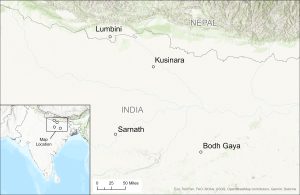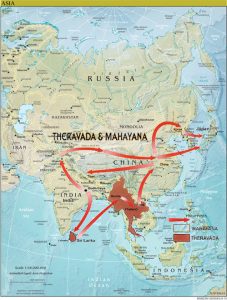14 Geography
Geography
Buddhism developed during a period of rapid cultural, political, and economic change in the northern region of India, a fertile area south of the Himalayas, nourished by the Ganges River, where rice was the primary agricultural product. This region had been settled for thousands of years. Archaeological sites at the ancient cities of Harappa and Mohenjo-daro show evidence of ancient, sophisticated, and well-organized cities that thrived thousands of years before the Aryan tribes entered the Indian subcontinent in approximately 1500 BCE. By the sixth century BCE, this area had a rich culture that combined aspects of the earliest settlers of the Ganges Plain and the Aryan tribes that had emigrated there.
When we speak of early Buddhism, remember that it began as a small movement in a fairly narrow geographical area in the northern Indian subcontinent. Prince Siddartha, born into a rulling family of the Sakya clan left home to discover the cause of suffering in the world through mental and physical discipline of meditation and restraint. After his experience of enlightenment he earned the title of Buddha or “awakened one”. The name Sakyamuni Buddha literally means “the awakened one who is the sage of the Sakya (clan)”. Buddhists recognize that the title of Buddha can be applied to anyone who has realized the cause of suffering. They believe that were other Buddhas before Sakyamuni Buddha over many eons of time. Sakyamuni Buddha is regarded as the most recent fully awakened Buddha.
Sakyamuni Buddha began a forty year career of teaching. He traveled around to various areas of northern India, teaching what he had learned through his deep practices of meditation and insight. Buddhist scriptures state that the Buddha recommended that his followers should visit four sites that were important in his life:
- Lumbini, the place of his birth.
- Bodh Gaya, the place where he achieved enlightenment.
- Sarnath, the place where he delivered his first sermon.
- Kusinagara, the place where the Buddha ended life and attained parinirvana

Buddhism spread to Southeast Asia and to East Asia along trade routes to the north of India that brought goods and ideas from India to East Asia: China, Korea, and Japan. These geographical expansions of Buddhism occurred hundreds of years apart.
Southeast Asia, which received Buddhism soon after the Buddha lived, preserved the early scriptures and practices. Theravada Buddhism, or “the way of the elders” refers to the contemporary form of this kind of Buddhism. In the modern period, Theravada Buddhist teachers have influenced the spread of mindfulness in Western countries.
China began to receive Buddhist ideas in the first century CE, about 500 years after the Buddha’s life. By this time Buddhists had developed new perspectives on the Buddha’s teaching which they expressed in Mahāyāna Buddhist scriptures. Theravada scriptures and Mahāyāna scriptures were imported to China together. As the Chinese translated these texts, schools developed around the principle teachings of these different Buddhst scriptures, for example Pure Land Scriptures, Lotus Sutra, Flower Garland Sutra, and the Perfection of Wisdom Scriptures. Chan or Zen Buddhism, which developed in seventh century China, combines Buddhist ideas with native Daoist ideas about “the Way” (see chapter on Daoism and Confucianism). In the twentieth century, Pure Land Buddhism and Zen Buddhism were brought to America by Japanese teachers who established communities and practice centers.
In the 8th century a new wave of esoteric religious practices affected many religions of India, including Buddhism. Esoteric means “secret” and such teachings could only be learned through a teacher who had studied and mastered these teachings. The practices of esoteric Buddhism are called Tantras and included visualizations and devotional practices. Esoteric tantric practices also developed in Hinduism and affected already established Buddhist groups in Tibet, China, Korea, and Japan.
Southeast Asia, Northern Asia, and East Asia developed different styles of practice and ideas about the nature of enlightenment that were influenced by the scriptures that they imported. Southeast Asian Buddhists practice teachings developed from early Buddhism. Chinese and East Asian Buddhists developed practices based on Mahāyāna scriptures; and Tibetan Buddhists developed Vajrayāna, based on Mahāyāna and Tantric teachings. Theravada, Mahāyāna, and Vajrayāna Buddhism all rely on the basic teachings that you will learn in this chapter. Buddhist scholars call these fundamental teachings Mainstream Buddhism because they are accepted so widely among Buddhists.

